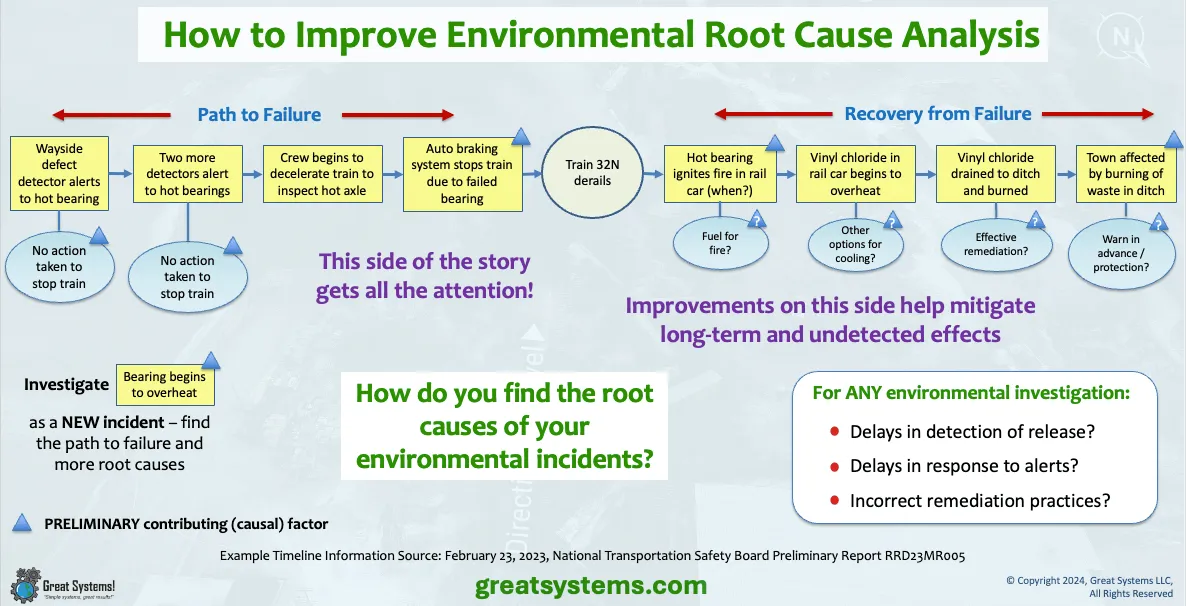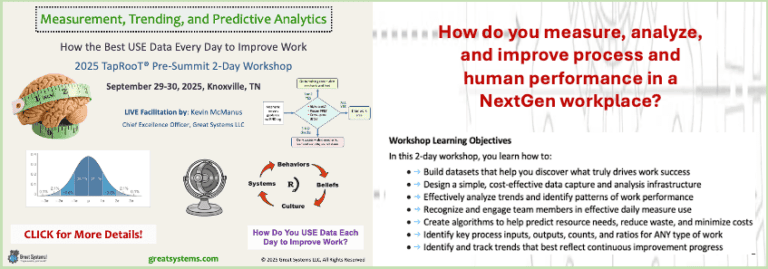Environmental Root Cause Analysis Best Practices

How Effective are Your Environmental Root Cause Analysis Practices?
On this page, I share five best practices to improve environmental investigation root cause analysis Note that this post does not suggest what type of root cause analysis process one should use. That is your call to make.
Instead, my intent with this post is to widen the scope of our environmental investigations.
That way, we won’t need as many trainwrecks to realize the environmental impact practice improvements that too many companies still need to make.
As a country, we are grossly inconsistent when it comes to environmental protection. In some states, we investigate any fuel spill more than eight ounces (250 ml). In other states, the threshold for the same spill quantity is much higher. I don’t expect consistency, but a little variation reduction may be in order.
As a country, we are grossly inconsistent when it comes to environmental protection. In some states, we investigate any fuel spill more than eight ounces (250 ml). In other states, the threshold for the same spill quantity is much higher. I don’t expect consistency, but a little variation reduction may be in order.
My larger concern is that weak investigation practices and fixes are prevalent in the environmental protection arena. We clean up the spills, but what about the less visible side effects of the release?
All too often, we think stability exists because some form of action was taken. However, what hidden hazards remain?
#1: Look past the trainwreck – Make the ‘path to failure’ visible in your timeline
We focus on the main event – the trainwreck that caused a major spill. Fewer pay attention to the effectiveness of the corrective actions people made after the event.
Consider the horrendous spill and contamination that occurred in East Palestine, Ohio, Just days after the National Transportation Safety Board (NTSB) issued its preliminary report, the media shared their ‘single cause’ focus. The NTSB report listed multiple contributing factors, but the media had found their promotional fix.
In many cases, both personal injury and environmental harm occur as part of an event such as a derailment, pipeline rupture, or facility fire. All too often, we pay excessive attention to the human condition in the short term at the potential expense of other areas.
Recently, I taught a 2-day onsite TapRooT® root cause analysis class with people whose only job focus was environmental investigations. They were in the course for one main reason.
Too many previous investigations made by others included only limited mention of errors and failures of an environmental nature. In other words, their investigation results failed to close environmental safeguard gaps.
To address this problem, make sure that the ‘path to failure’ path is evident in your timeline. What failures preceded the spill or exceedance? To what degree did we detect, respond, and mitigate the release as expected?
Consider the horrendous spill and contamination that occurred in East Palestine, Ohio, Just days after the National Transportation Safety Board (NTSB) issued its preliminary report, the media shared their ‘single cause’ focus. The NTSB report listed multiple contributing factors, but the media had found their promotional fix.
In many cases, both personal injury and environmental harm occur as part of an event such as a derailment, pipeline rupture, or facility fire. All too often, we pay excessive attention to the human condition in the short term at the potential expense of other areas.
Recently, I taught a 2-day onsite TapRooT® root cause analysis class with people whose only job focus was environmental investigations. They were in the course for one main reason.
Too many previous investigations made by others included only limited mention of errors and failures of an environmental nature. In other words, their investigation results failed to close environmental safeguard gaps.
To address this problem, make sure that the ‘path to failure’ path is evident in your timeline. What failures preceded the spill or exceedance? To what degree did we detect, respond, and mitigate the release as expected?
How do you find root causes? To effectively analyze an environmental release or exceedence, multiple root causes must be found. This video compares five of the most common root cause analysis approaches.
WATCH over 50 kaizen and workplace health improvement videos on my Great Systems YouTube channel.
WATCH over 50 kaizen and workplace health improvement videos on my Great Systems YouTube channel.
#2: Improve real-time data and evidence capture at the scene during the initial 24-hour evidence grab
Incident scenes are emotional, and at time chaotic, environments. As such, it is easy to distort, delete, and generalize about the different things that make up the incident story line.
Plus, memories rarely last. Today’s technology makes it much easier to capture real-time evidence at the scene.
How often do your investigators have the tools and skills necessary to leverage such Jetsonian advantages? What role will voice recognition, video and hands-free data capture, 5G data speeds, and environmental and biometric analysis play in your environmental investigation future?
For example, video and voice recordings should be standard practice in such situations. However, do we have functional headsets (or earbuds) and a cloud service to capture the evidence?
Is the use of such technology for evidence capture part of our investigation protocol and quick response kit?
How can we use services like Quickbase and no-code apps to make written evidence capture in the field easier? What are the pros and cons for investigator body cam use?
How can biometric and environmental sensor use on our smart devices help capture environmental evidence or its effects on the public?
#3: Expect, and seek out, multiple contributing factors to help reduce future incident risk levels
In Western culture, people struggle to see systems. As Peter Senge says, they are conditioned to respond to events. When the media blames a wheel bearing for a derailment, it lessens the focus on other contributing factors.
All too often, significant remediation errors lead to excessive pollution. However, we often fail to perform root cause analysis on such errors, let alone fix them.
The parallels between the 2013 Lac-Megantic train derailment and the 2023 East Palestine derailment contributing factors concern me. If we look at the multiple ‘flammable liquid’ derailments in North America over the past ten years, we see common problems.
That said, how much public awareness exists relative to the need for double-hulled railcars? Can they look out the window and tell if the railroad follows the rules?
Let the media pick their favorite error to fixate on. Internally, teach your investigators how environmental incidents often unfold.
Help them learn to look for equipment failures that often initiate a release. Help them learn to find the path to failure for such equipment failures.
Most importantly, teach them to ‘look past the train wreck.'
All too often, significant remediation errors lead to excessive pollution. However, we often fail to perform root cause analysis on such errors, let alone fix them.
The parallels between the 2013 Lac-Megantic train derailment and the 2023 East Palestine derailment contributing factors concern me. If we look at the multiple ‘flammable liquid’ derailments in North America over the past ten years, we see common problems.
That said, how much public awareness exists relative to the need for double-hulled railcars? Can they look out the window and tell if the railroad follows the rules?
Let the media pick their favorite error to fixate on. Internally, teach your investigators how environmental incidents often unfold.
Help them learn to look for equipment failures that often initiate a release. Help them learn to find the path to failure for such equipment failures.
Most importantly, teach them to ‘look past the train wreck.'
#4: Always explore the root causes of (1) failures to follow recommended regulation and (2) failures to effectively enforce regulatory practices at all company levels
We allow states to practice different environmental laws, despite the impact difference. For example, they still 'open air' drop coal into rail cars in some states. However, West Coast states must fully contain coal dust during loading. Even then, people protest their presence.
I lived in both areas, and the difference is noticeable. Is that difference worthy of a federal mandate?
Where should we set the limit for such practices? When do we break the rules? How often do leaders know when they violate environmental regulations?
Just a Brief Note on Rule Violations and Environmental Root Cause Analysis
As we build both our paths ‘to failure’ and ‘recovery from failure’ into our investigation timeline, we must think about intentional and unintentional rule violations. The distinction is significant in environmental root cause analysis.
It directly affects the type of corrective and preventive action one might propose. We should expect and allow the courts to treat willful violation differently.
The site’s mission statement should serve as the local environmental practice guide. Work sites should support their key communities, not poison them.
When it comes to environmental and community damage, one's lobby for a sentence or fine reduction should not be an 'easy out.'
#5: Consistently work to raise community awareness of real risk and hazard potential, plus expected and reasonable mitigation actions
I grew up in a rural paper mill town. I love that town. Today, Crossett, AR is the focus of a documentary called ‘Company Town.’ For years, the paper mill in Crossett discharged waste into the local woods and creeks.
Much of this pollution occurred prior to the creation of the Environmental Protection Agency (EPA) in 1970. Still, even after problem detection, it was difficult to get others to believe it even existed.
As members of the community, we accepted this pollution as normal. I lived and played near Stink Creek. I thought nothing of the colorful bubbles and foam always floated on the creek’s surface.
Similarly, too many communities are unaware of the hazards that exist in their proximity. Sadly, we can even say this for employees of those companies in some cases.
All too often, improvements are made to get under threshold reporting levels. This does not mean no more releases can occur. They just need to be under the threshold.
If a company consistently releases something hazardous into the environment, they should be transparent about it. At the same time, communities must learn to be realistic about the tradeoffs that come with added protection.
Much of this pollution occurred prior to the creation of the Environmental Protection Agency (EPA) in 1970. Still, even after problem detection, it was difficult to get others to believe it even existed.
As members of the community, we accepted this pollution as normal. I lived and played near Stink Creek. I thought nothing of the colorful bubbles and foam always floated on the creek’s surface.
Similarly, too many communities are unaware of the hazards that exist in their proximity. Sadly, we can even say this for employees of those companies in some cases.
All too often, improvements are made to get under threshold reporting levels. This does not mean no more releases can occur. They just need to be under the threshold.
If a company consistently releases something hazardous into the environment, they should be transparent about it. At the same time, communities must learn to be realistic about the tradeoffs that come with added protection.
Would you like to improve how you conduct environmental investigation root cause analysis?
The questions we ask drive investigation quality. What did people do wrong, or fail to do, AFTER the derailment that made things worse? We must find and fix the root causes of these environmental errors if we truly want sustainability.
Do you have a team of people who do environmental investigations, but they work at a variety of locations? If so, a TapRooT® 3-day virtual root cause analysis course might give you a good way to help all of them improve their investigation skills at one time.
Please let me know if you would like me to teach a TapRooT® 3-day virtual root cause analysis course to your environmental team. If you want more information on this topic, feel free to connect with me.
Do you have a team of people who do environmental investigations, but they work at a variety of locations? If so, a TapRooT® 3-day virtual root cause analysis course might give you a good way to help all of them improve their investigation skills at one time.
Please let me know if you would like me to teach a TapRooT® 3-day virtual root cause analysis course to your environmental team. If you want more information on this topic, feel free to connect with me.


